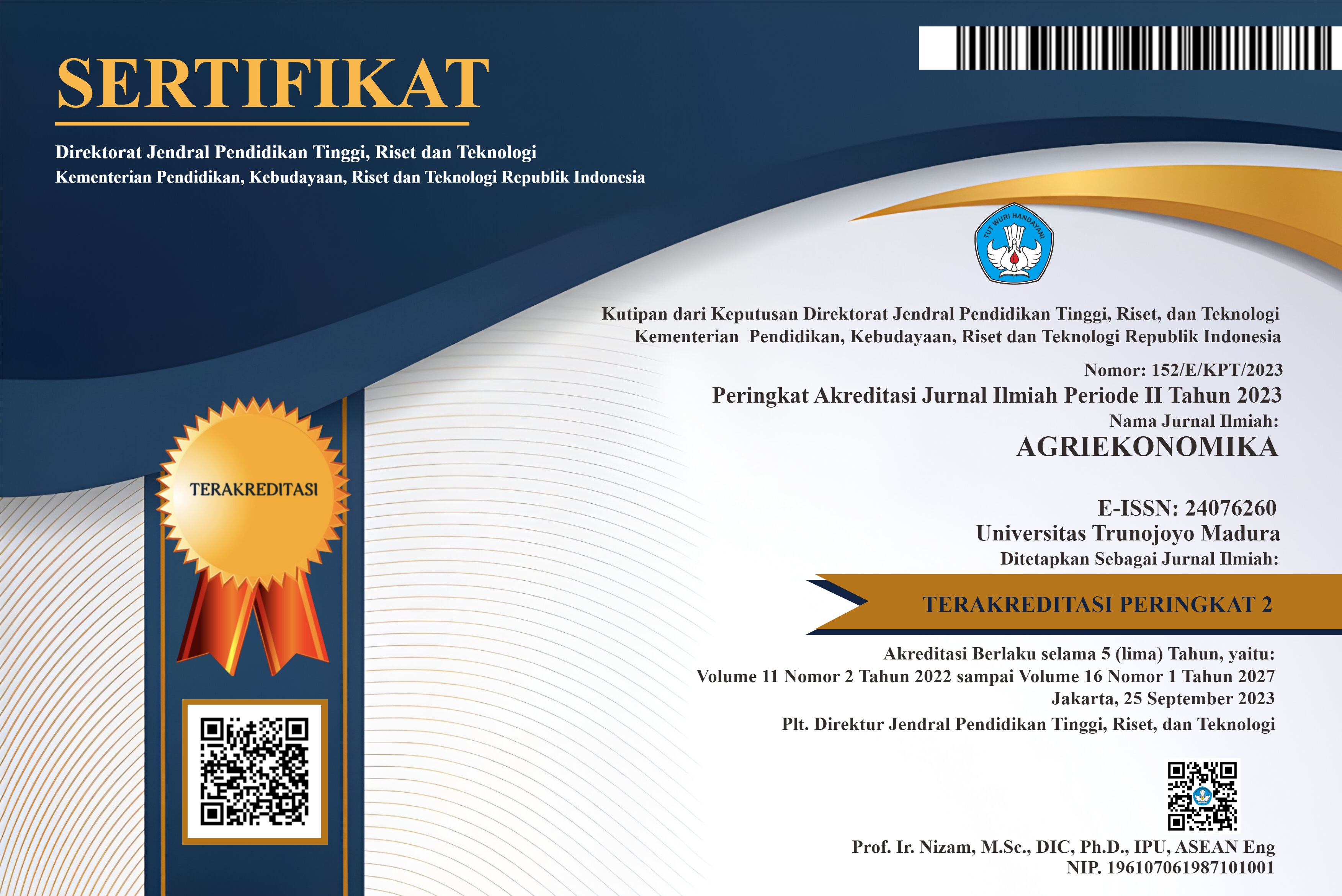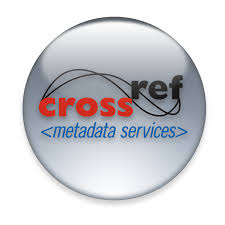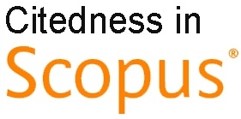Evaluation of PIAT UGM Herbal Drink: SWOT Analysis
Abstract
Keywords
Full Text:
PDFReferences
Afrianto, A., Malik, D., & Hasiholan, L. B. (2017). Strategy Business Development of Companies through SWOT Analysis (Study at PT. Sido Muncul, Tbk Semarang District). Jurnal Ekonomi Dan Bisnis Kontemporer, 3(1).
Akhiroh, P., Masyithoh, D., & Susilo, A. (2021). Electronic Word of Mouth Pemasaran Madu Era Covid-19 di Wilayah Malang. Agriekonomika, 10(1), 19–26.
Arvianti, E. Y., Anggrasari, H., & Masyhuri, M. (2022). Pemanfaatan Teknologi Komunikasi melalui Digital Marketing pada Petani Milenial di Kota Batu, Jawa Timur. AGRIEKONOMIKA, 11(1), 11–18.
Brooks, G., Heffner, A., & Henderson, D. (2014). A SWOT Analysis of Competitive Knowledge from Social Media for a Small Start-up Business. Review of Business Information Systems (RBIS), 18(1), 23–34.
David, M. E., David, F. R., & David, F. R. (2017). The Quantitative Strategic Planning Matrix: A New Marketing Tool. Journal of Strategic Marketing, 25(4), 342–352.
Dwisatyadini, M. (2017). Pemanfaatan tanaman obat untuk pencegahan dan pengobatan penyakit degeneratif. Optimalisasi Peran Sains Dan Teknologi Untuk Mewujudkan Smart City, 2, 237–270.
Istiatin, I., & Marwati, F. S. (2021). Sosialisasi Berbagai Peluang Usaha UMKM dan Ekonomi Kreatif di Era New Normal di Dusun Pinggir Desa Telukan Sukoharjo. Budimas: Jurnal Pengabdian Masyarakat, 3(1), 129–140.
Kolbina, O. (2015). SWOT Analysis as a Strategic Planning Tool for Companies in the Food Industry. Problems of Economic Transition, 57(9), 74–83.
Kostewicz, D. E., King, S. A., Datchuk, S. M., Brennan, K. M., & Casey, S. D. (2016). Data Collection and Measurement Assessment in Behavioral Research: 1958–2013. Behavior Analysis: Research and Practice, 16(1), 19.
Mafruchati, M. (2020). The use of dates against COVID-19, based on effectiveness or religion’s believe? trends and relevance analysis in big data. Vaccine, 1(0).
Mandira, A., Swikno, S., Fadilah, M., & Sunaryo, D. (2020). Strategi Marketing Teh Rempah “Uwuhable” di Era Urbanisme dan Pandemi Covid-19. Inovasi Manajemen Dan Kebijakan Publik, 3(2), 14. https://doi.org/10.54980/imkp.v3i2.121
Namugenyi, C., Nimmagadda, S. L., & Reiners, T. (2019). Design of a SWOT Analysis Model and Its Evaluation in Diverse Digital Business Ecosystem Contexts. Procedia Computer Science, 159, 1145–1154.
Nassaji, H. (2015). Qualitative and descriptive research: Data type versus data analysis. Language Teaching Research, 19(2), 129–132. https://doi.org/10.1177/1362168815572747
Nurmayasari, A., & Mu’tamar, M. F. F. (2018). Strategi Pengembangan Agroindustri Jamu di Jawa Timur. Jurnal Teknologi & Industri Hasil Pertanian Vol, 23(2), 57.
Oreski, D. (2012). Strategy Development by Using SWOT-AHP. TEM Journal, 1(4), 283–291.
Phadermrod, B., Crowder, R. M., & Wills, G. B. (2019). Importance-Performance Analysis based SWOT analysis. International Journal of Information Management, 44, 194–203. https://doi.org/10.1016/j.ijinfomgt.2016.03.009
Pramestya, A. N., Aryanto, H., & Maer, B. D. A. (2020). Perancangan Strategi Brangding Teh Herbal Produksi “SWARNA” Yogyakarta. Jurnal DKV Adiwarna, 1(16), 10.
Rachmatullah, H. F., Eka, L., Rizki, S. D., Wulan, A., Prasetya, M. A., & MM, I. S. S. T. (2019). Impementasi Kewirausahaan melalui Studi Kelayakan Bisnis Sirup Herbal “Tenan’e Healthy Sirup.” Inovasi Manajemen Dan Kebijakan Publik, 2(1), 20–32.
Rayagina, D., Alam, A. S., Nurkamil, Y., Agribisnis, S., Terapan, F. S., Suryakancana, U., Agribisnis, S., Terapan, F. S., Suryakancana, U., & Pala, E. S. (2022). Business Development Strategy PKH Group Nutmeg Juice Extract Sukawangi Village. 4(1), 1–14.
Rozmi, A. N. A. (2018). The Perception of ICT Adoption in Small Medium Enterprise: A SWOT Analysis. International Journal of Innovation and Business Strategy (IJIBS), 9(1).
Ruslim, J. C., Hagijanto, A. D., Malkisedek, M. H., Studi, P., Komunikasi, D., Humaniora, F., & Kristen, U. (2022). Perancangan Promosi Minuman Herbal Modern Jamoe Kowe sebagai Minuman Sehat dan Menyegarkan. Jurnal DKV Adiwarna, 1, 1–9.
Singh, A. S., & Masuku, M. (2014). Sampling Techniques and the determints of sample size in applied statistics. International Journal of Economics , Commerce and Management, 2(11), 1–22. http://ijecm.co.uk/
Trisnaningsih, A., Arisyahidin, & Talkah, A. (2022). Analisis Kelayakan Usaha Varian Minuman Herbal Hasil Praktek APHP Di SMKN 1 Plosoklaten Kedir. Magister Agribisnis: Jurnal Agribisnis, 22(3), 146–151.
Vlados, C. (2019). On a Correlative and Evolutionary SWOT Analysis. Journal of Strategy and Management, 12(3), 347–363.
Wu, Y. (2020). The Marketing Strategies of IKEA in China Using Tools of PESTEL, Five Forces Model and SWOT analysis. International Academic Conference on Frontiers in Social Sciences and Management Innovation (IAFSM 2019), 348–355.
DOI: https://doi.org/10.21107/agriekonomika.v12i1.17161
Refbacks
- There are currently no refbacks.







